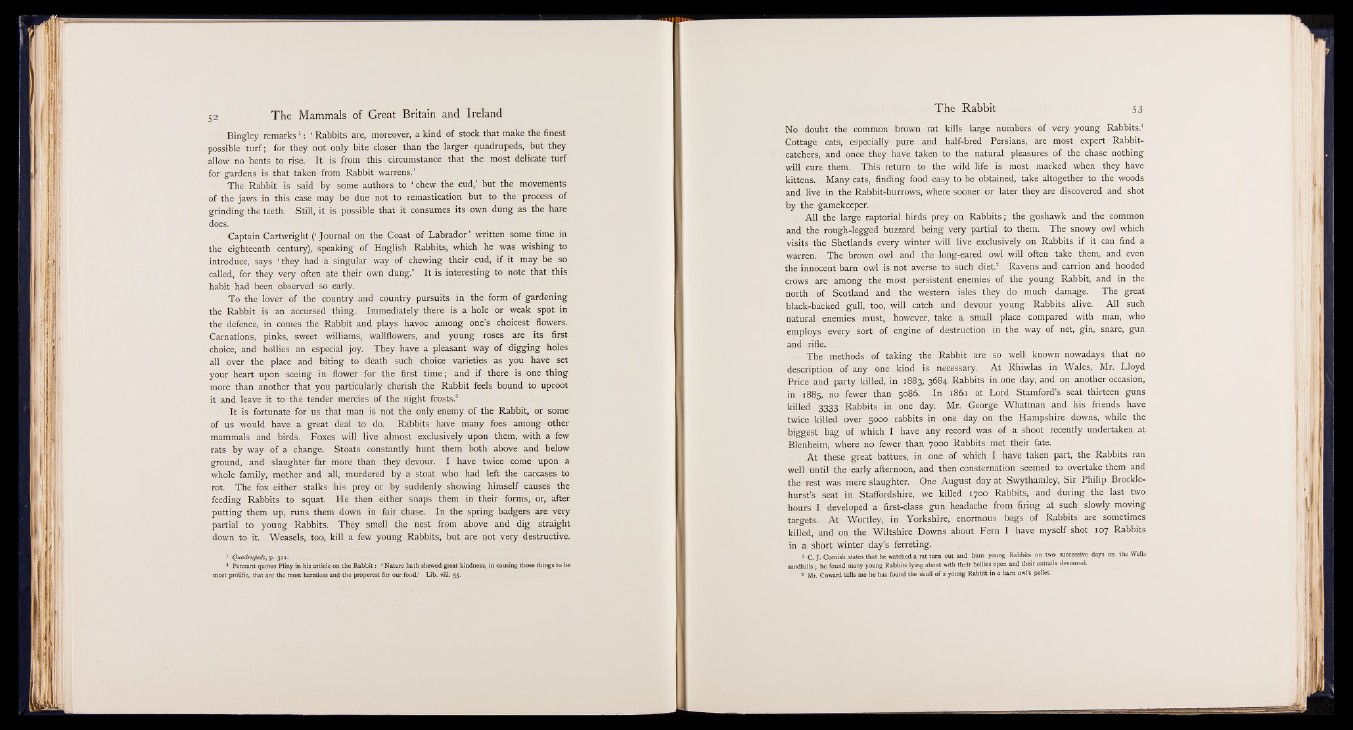
Bingley remarks1: ‘ Rabbits are, moreover, a kind of stock that make the finest
possible turf; for they not only bite closer than the larger quadrupeds, but they
allow no bents to rise. It is from this circumstance that the most delicate turf
for gardens is that taken from Rabbit warrens.’
The Rabbit is said by some authors to ‘ chew the cud,’ but the movements
of the jaws in this case may be due not to remastication but to the process of
grinding the teeth. Still, it is possible that it consumes its own dung as the hare
does.
Captain Cartwright (‘ Journal on the Coast of Labrador’ written some time in
the eighteenth century), speaking of English Rabbits, which he was wishing to
introduce, says ‘ they had a singular way of chewing their cud, if it may be so
called, for they very often ate their own dung.’ It is interesting to note that this
habit had been observed so early.
To the lover of the country and country pursuits in the form of gardening
the Rabbit is an accursed thing. Immediately there is a hole or weak spot in
the defence, in comes the Rabbit and plays havoc among one’s choicest flowers.
Carnations, pinks, sweet williams, wallflowers, and young roses are its first
choice, and hollies an especial joy. They have a pleasant way of digging holes
all over the place and biting to death such choice varieties as you have set
your heart upon seeing in flower for the first time; and if there is one thing
more than another that you particularly cherish the Rabbit feels bound to uproot
it and leave it to the tender mercies of the night frosts.2
It is fortunate for us that man is not the only enemy of the Rabbit, or some
of us would have a great deal to do. Rabbits have many foes among other
mammals and birds. Foxes will live almost exclusively upon them, with a few
rats by way of a change. Stoats constantly hunt them both above and below
ground, and slaughter far more than they devour. I have twice come upon a
whole family, mother and all, murdered by a stoat who had left the carcases to
rot. The fox either stalks his prey or by suddenly showing himself causes the
feeding Rabbits to squat. He then either snaps them in their forms, or, after
putting them up, runs them down in fair chase. In the spring badgers are very
partial to young Rabbits. They smell the nest from above and dig straight
down to it. Weasels, too, kill a few young Rabbits, but are not very destructive.
1 Quadrupeds, p. 3x1.
* Pennant quotes Pliny in his article on the Rabbit: ‘ Nature hath shewed great kindness, in causing those things to be
most prolific, that are the most harmless and the properest for our food.’ Lib. viii. 55.
No doubt the common brown rat kills large numbers of very young Rabbits.1
Cottage cats, especially pure and half-bred Persians, are most expert Rabbit-
catchers, and once they have taken to the natural pleasures of the chase nothing
will cure them. This return to the wild life is most marked when they have
kittens. Many cats, finding food easy to be obtained, take altogether to the woods
and live in the Rabbit-burrows, where sooner or later they are discovered and shot
by the gamekeeper.
All the large raptorial birds prey on Rabbits; the goshawk and the common
and the rough-legged buzzard being very partial to them. The snowy owl which
visits the Shetlands every winter will live exclusively on Rabbits if it can find a
warren. The brown owl and the long-eared owl will often take them, and even
the innocent barn owl is not averse to such diet.2 Ravens and carrion and hooded
crows are among the most persistent enemies of the young Rabbit, and in the
north of Scotland and the western isles they do much damage. The great
black-backed gull, too, will catch and devour young Rabbits alive. All such
natural enemies must, however, take a small place compared with man, who
employs every sort of engine of destruction in the way of net, gin, snare, gun
and rifle.
The methods of taking the Rabbit are so well known nowadays that no
description of any one kind is necessary. At Rhiwlas in Wales, Mr. Lloyd
Price and party killed, in 1883, 3684 Rabbits in one day, and on another occasion,
in 1885, no fewer than 5086. In 1861 at Lord Stamford’s seat thirteen guns
killed 3333 Rabbits in one day. Mr. George Whatman and his friends have
twice killed over 5000 rabbits in one day on the Hampshire downs, while the
biggest bag of which I have any record was of a shoot recently undertaken at
Blenheim, where no fewer than 7000 Rabbits met their fate.
At these great battues, in one of which I have taken part, the Rabbits ran
well until the early afternoon, and then consternation seemed to overtake them and
the rest was mere slaughter. One August day at Swythamley, Sir Philip Brockle-
hurst’s seat in Staffordshire, we killed 1700 Rabbits, and during the last two
hours I developed a first-class gun headache from firing at such slowly moving
targets. At Wortley, in Yorkshire, enormous bags of Rabbits are sometimes
killed, and on the Wiltshire Downs about Fern I have myself shot 107 Rabbits
in a short winter day’s ferreting.
1 C. J. Cornish states that he watched a rat turn out and hunt young Rabbits on two successive days on the Wells
sandhills ; he found many young Rabbits lying about with their bellies open and their entrails devoured.
* Mr. Coward tells me he has found the skull of a young Rabbit in a barn owl’s pellet.